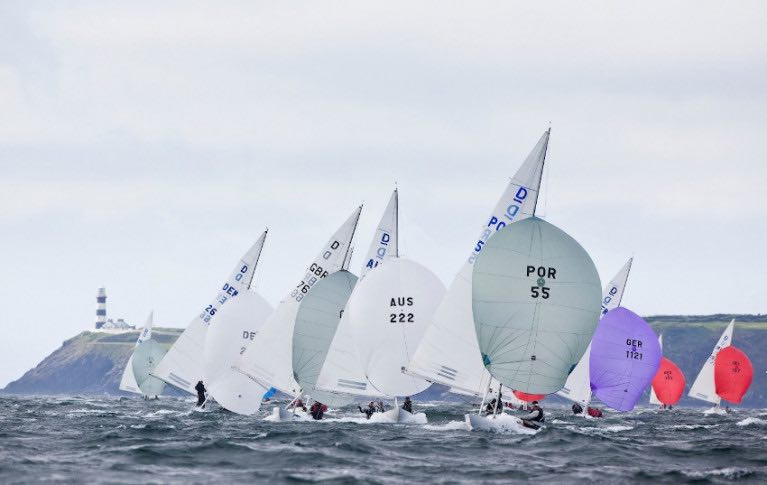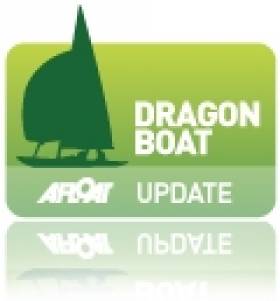Displaying items by tag: Dragon Gold Cup
There was good news from Kinsale this week as a yacht club member, Stephen McCarthy and his construction company Astra Construction have become the Gold sponsor to back the yacht clubs' hosting of the Dragon Gold Cup in 2024.
After the disappointment of having to cancel the 2020 event, Kinsale has been rewarded with the hosting of the 2024 edition, an exceptionally prestigious event that has in the past attracted royalty and Olympic winners.
Speaking of the sponsorship Stephen McCarthy, himself a keen sailor and father to offshore supremo Cian McCarthy, wanted to support Kinsale Yacht Club, and the Gold Cup was the perfect match for him.
Stephen commented, "Astra Construction are delighted to be on board for the 2024 Dragon Gold Cup. Although we are the title sponsor, our primary aim is to promote our wonderful Yacht Club and have the event called the Kinsale Yacht Club Gold Cup 2024. I am excited to be involved so early in the cycle and look forward to working with the organisers to ensure a truly memorable and successful event."
Michael Walsh Commodore of Kinsale Yacht Club welcomed the announcement by adding, "Stephen has been incredibly generous, not only by becoming the Gold sponsor of the event but also offering his time and energy to help in any way with the other volunteers in running the event to the exacting detail required of the Gold Cup Deed of Gift. Kinsale Yacht Club's success is based around its volunteers, and Stephen has absolutely defined what the Yacht Club is all about by not only sponsoring the event but also volunteering to help out."
Daniel Murphy of the 2024 organising committee and current Dragon class captain commented that "Work has already begun here in Kinsale for 2024. We are delighted to welcome Stephen and thank him for his support and faith in us to run a world-class event. The Dragon class in Kinsale is certainly enjoying a rejuvenation at present, with a growing fleet of active and competitive boats and more on the horizon. The attraction to the fleet in Kinsale is the fun and camaraderie within the group and being able to sail in a beautiful venue like Kinsale."
It is fair to say that all in Kinsale Yacht Club already have their eye firmly on running a spectacular event in 2024, the yacht clubs' third time welcoming the Gold Cup to Kinsale.
Kinsale Yacht Club to Host Dragon Gold Cup in 2024
After the disappointment of being forced to cancel its hosting of the Dragon Gold Cup due to coronavirus restrictions, Kinsale Yacht Club has expressed delight at being awarded the event again in 2024.
Dragons recently returned to the waters at the West Cork harbour while conditions allowed, attempting to salvage a season that saw both September’s Gold Cup and its replacement Cantor Fitzgerald Dragon Week called off.
Kinsale will also host the combined Irish and UK Nationals for Squibs in 2022, as previously reported on Afloat.ie.
Kinsale Yacht Club Shares Its 2020 Vision
With the Kinsale Yacht Club commodore baton being passed from David O’Sullivan to Michael Walsh in December last year, the new commodore is rallying his troops for a busy year ahead, writes the club’s Brian Goggin.
One busy committee member will surely be Matthias Hellstern, who moves into the vice commodore position with responsibility for sailing.
And there is certainly plenty of sailing this season in Kinsale despite it not being a Sovereign’s Cup year.
The hardy sailors will test the waters next month for the custom rigging Frostbites, with the cruisers getting dusted down and going racing in March for the Frank Godsell League.
April brings the highly competitive Cruiser Spring Series and will also see the Dragons launch, somewhat earlier than normal, with a training weekend planned with international sailor and coach Martin Payne.
May sees the Barry Ryan Keelboat Regatta for Dragons and Squibs, numerous club trophy races and the competitive national events will truly kick off with the Optimist Munsters.
The Toppers and Triangle Race visit in June, a month which will also see one of the biggest events in Kinsale this summer with the Squib (British) Nationals. Eyes will firmly be on local Squibbers Colm Dunne and Ian Travers to see if they can maintain their 2019 form and cause an upset against the other top English and Irish teams.
July sees the juniors take over with sailing courses and it also looks to be an incredibly intensive year for some of Kinsale’s brightest talent
July sees the juniors take over with sailing courses and it also looks to be an incredibly intensive year both nationally and internationally for some of Kinsale’s brightest talent so be sure to watch out for names such as Michéal O’Sullivan, Dorothy Matthews and Francesca Lewis.
July also means Cork Week and the Kinsale cruisers and Dragons will make the short trip over to our friends in the Royal Cork to help celebrate their 300-year anniversary.
August will see many cruisers head west for Calves Week, numerous club trophies and of course Kinsale Regatta. The Dragons will also get getting ready for the Gold Cup with a warmup event on the last weekend of August.
Of course, Kinsale is well respected for its sailability class and the club can look back proudly at the incredibly successful and enjoyable inclusion games run last year.
Under the watchful eye of Donal Hickey, this class continues to go from strength to strength and Kinsale will send upwards of 30 sailors to the President’s Cup and Hansa Nationals in Carrigfergus in August, as well as a busy local schedule of events and weekend sailing. Donal is also busily fundraising for additional boats due to the demand of more sailors looking to join the fun.
The ‘big one’ lands in September with the Dragon Gold Cup and over 70 boats are expected to join the strong South Coast contingent
The ‘big one’ lands in September with the Dragon Gold Cup and over 70 boats are expected to join the strong South Coast contingent.
This event was awarded to Kinsale on the back of the successful 2012 event and already event director Tony Kingston reports that entries have been received from Switzerland, Portugal, Spain, UK and Belgium, with lots more expected over the coming months.
The home club expect to have eight Kinsale boats competing and should certainly be represented at the sharp end of the fleet with Cameron Good and crew on Little Fella among the ones to watch.
September is also the month for the always popular at-home regatta, while October to December will see local leagues and club trophies return. The season wraps up on St Stephen’s Day with the popular Gunsmoke Bell, sponsored by the evergreen Sammy Cohen, a man who can be credited with showing many of Kinsale’s finest sailors the ropes and the joys of yacht racing
Of course, Kinsale is a club that is dependent on its volunteers and Dave Cullinane, sailing secretary and winner of the club person of the year, will be totally reliant on volunteers to run all of the events — something for which Kinsale is tremendously grateful and proud of its members and sponsors.
Kinsale Yacht Club Gears Up For Dragon Gold Cup
#DRAGON - Following on from the recent successes of the Volvo Ocean Race in Galway and the Tall Ships Races in Dublin, Kinsale Yacht Club is set to host another major international sailing event in the Brewin Dolphin Dragon Gold Cup from 8-14 September.
Over 60 boats and 200 sailors from Japan, Hong Kong, Russia, Ukraine, Sweden, Germany, Finland, France, Portugal, Denmark and Monaco as well as strong fleets from both Ireland and the UK will compete in the what is considered the World Cup of Dragon sailing.
Among the competitive fleet sailing in the open waters off the Old Head of Kinsale will be several world champions and former Olympians including current Dragon Gold Cup holder Marcus Wieser, Tommy Muller, Vincent Hoesch, Volvo Ocean Race veteran Lawrie Smith and current Irish National Dragon Champion Poul Richard Hoj-Jensen.
Between them, their accomplishments include two Olympic gold medals and Volvo Ocean Race and America’s Cup campaigns.
Also competing are Jorgen Schoner, winner of three Dragon Gold Cups; Lars Hendriksen, winner of two Dragon Gold Cups and two European Dragon Championships, and former British Olympian and America’s Cup sailor Andy Beasworth who will be joining Klaus Diedreichs.
Closer to home, the Irish Dragon fleet will be well represented by the Edinburgh Cup winner Simon Brien as well as established campaigners Martin Byrne from Dun Laoghaire, Don O’Donoghue, Andrew Craig and Cameron Good from Kinsale.
“We are delighted to host the prestigious Dragon Gold Cup at Kinsale Yacht Club this season and look forward to welcoming a world-class fleet to Kinsale for a full racing and social programme,” remarked Good, Commodore of Kinsale Yacht Club.
Meanwhile, the Irish Dragon South Coast Championships are taking place this weekend 1-2 September to serve as a 'warm up' event for the Gold Cup. Entries are still open for both events. See www.kyc.ie for regular updates.
































































